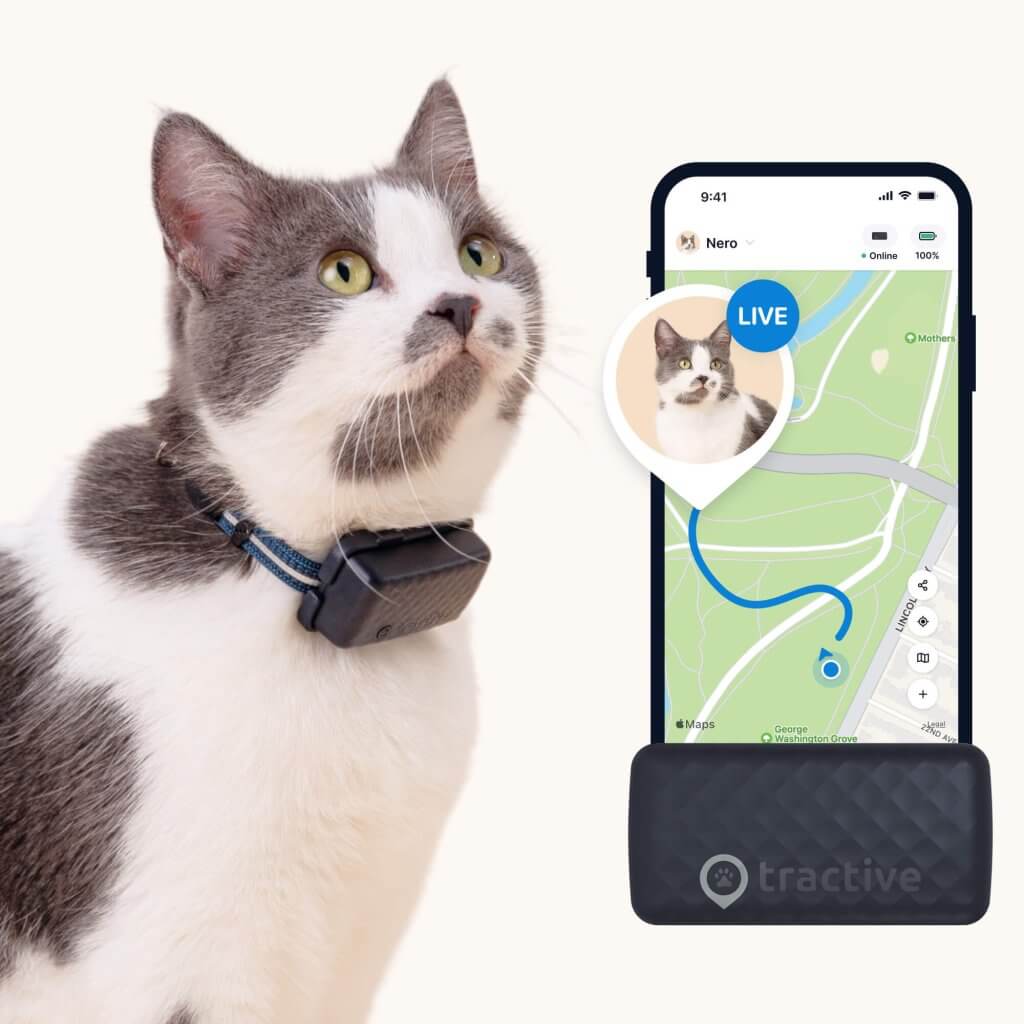New Kitten Checklist: How To Prepare for Your New Cat
A new kitten is an exciting addition to your household. Get ready with these new kitten tips and our checklist of all the essentials you’ll need to welcome your fluffy feline friend.

As adorable as they can be, your new little buddy requires more than love to survive. Here’s a new kitten checklist to help you to plan ahead and be prepared with the right food, vet care, and playthings to help your kitten grow up healthy and well adjusted. (Plus where a cat GPS tracker can come in handy.)

Find out where your cat spends their time.
Read moreBefore you bring your new kitten home
The first part of the new kitten checklist involves what you need to do before evening bringing kitty home.
- Choose a veterinarian for your kitten
Your kitten will need veterinary care throughout their life, so select a veterinarian before your kitty arrives. Schedule a well-kitten checkup right away, so your new pet gets off to a healthy start. Depending on your kitten’s age and where they came from, they may need vaccinations or deworming right away. The shots given at the first veterinary visit are especially important to protect other pets living in your home. - Plan to bring your kitten home at 8-12 weeks old
It’s possible to bring a kitten home when they are just 8 weeks old, but most experts recommend waiting until the kitten is 12 weeks old before separating them from their mother and littermates. Those extra weeks with mom and siblings can be beneficial for your kitten’s socialization and health.
Kitten-proof your home
Make your home kitten-proof and safe by putting away or covering up anything that your new kitten might play with, chew on, climb on, crawl into, or otherwise get into trouble with. Here are some tips:
- Put away anything your kitten could swallow
Like strings, threads, ribbon, and rubber bands, which can be ingested and cause intestinal blockage. - Cover up small openings
Like behind the refrigerator, where your kitten can wedge themselves in and get stuck. - Keep houseplants out of reach
Many of these are toxic to pets. Check the ASPCA’s toxic and non-toxic plants list for comprehensive advice. - Get in the habit of checking the “snug” spots
Like inside the washer, dryer, laundry basket, drawers, cabinets, and closets before closing them – there could be a curious kitten inside! - Keep all pills inside a container or cabinet
Don’t leave them lying about in the open. These could be toxic to cats if ingested. - Put breakable or delicate items away or inside a cabinet.
If you forget to address a potential hazard, your kitten will definitely find it for you! Plan to be extra-vigilant in the first days and weeks that your new kitten lives in your home.
Create a safe zone for your kitten
Before bringing your new kitten home, choose a room that will become your kitten’s personal safe space for a few days after they arrive. A guest bedroom is a good option, or any room that you can close off from the rest of the house. Place a tall baby gate securely across the entry door.
This safe zone will be where your kitten gets to know its new surroundings and its new family. Remember, your home is big and unfamiliar to your new kitten. By confining your kitten to this smaller room for a short time, you allow them to settle in and get accustomed to all the new sights, smells, and sounds in your home, as well as the people in it.
New kitten checklist: Essential equipment for your new cat
Food items
- Kitten food
Which your new kitten will eat for the first year of life. Your vet can best advise you what’s a good choice. - Food and water dishes
Plan to wash these bowls every day. Stainless steel bowls are easy to sanitize. - Treats
These can help you train your cat to use their new bed, litter box, or carrier. (As a bonus, it also helps you score some brownie points with your new kitten.) - Water fountain
To entice them to drink more water and stay hydrated. Wait a while before introducing a water fountain to your new kitten, until they are large enough to safely interact with the fountain.
Hygiene items
- Cat litter and scoop
Scoopable, unscented cat litter is a good option. If possible, use the same litter as the breeder from which you are obtaining the kitten. - Litter box
Choose an uncovered litter box with low sides so your kitten can get in and out easily. Switch to a larger, covered box and the litter of your choice as your kitten grows. Kittens instinctively know what the litter box is for, once you show them its location.
Indoor items
- Cat bed
Cats will naturally find plenty of comfy places to snooze. If you want to train your kitten to always sleep in a certain place or on a cat bed, start now. - Cat brush
Regular brushing helps to control the potential fur blizzard you may encounter if you wait too long between brushings. As a bonus, brushing sessions are a great way to bond with your kitty. - Cat toys and boxes
Small balls or catnip-stuffed toy mice might be perfect for kitty to play with alone. Use string, wand-style toys, or crinkly bags only when you are present. A small cardboard box tipped on its side can be a perfect hiding spot too. - Scratching post
Praise your kitten when they use the scratching post to sharpen their claws. You want to reinforce this behavior to avoid having kitty scratch the furniture or drapes instead. Sisal-covered posts are a good choice. - Cat tree
A multi-level cat tree will give your kitten something to climb on other than your household furnishings. Many cat trees include tunnels, sleeping platforms, and built-in scratching posts. - Cleaning supplies
Accidents happen, so be prepared with cleaning supplies such as a carpet cleaning spray that is specially formulated to remove pet messes and odors. Cat wipes can be used to remove dander and saliva from your cat’s fur. Air fresheners can help reduce pet odors in the home.
“Outdoor” items
- Cat carrier
Teach your kitten to love their pet carrier from day one by placing treats, a familiar-scented blanket, or toys inside. Being comfortable with the cat carrier will make car rides and vet visits less stressful for your kitten in the future. - Cat collar
A cat collar and ID tags are essential for your cat’s safety in case they escape your home. Learn more about cat collar training. - GPS cat tracker
Last but not least, a GPS cat tracker can be your new best friend when it comes to having peace of mind about your new kitten. Follow your kitten’s every step in the Tractive GPS app so that you never have to worry about losing your beloved feline friend. Check it out on Minho below 😻
Read real Tractive GPS customer reviews on Trustpilot
Bringing your kitten home for the first time
The big day is here! While it may be exciting for you, it could still be a little scary for your kitten. Try not to overwhelm your little furball right away. Take it slow and you’ll make the transition easier for your kitty. So here are some more new kitten checklist items for bringing home your cat.
Use a cat carrier in the car
When picking up your kitten from the breeder, place it directly into a cat carrier. If possible, ask the breeder for a piece of blanket or towel from the kitten’s sleeping area. Place this in your carrier, and the familiar smells of their mother and littermates will comfort your kitten on the ride home. Put a few kitten-appropriate treats in the carrier, too.
While in the car, talk gently to your kitten and avoid playing loud music or honking the horn. Make the ride as peaceful as possible.
Place your kitten in the safe zone
Once in the house, carry your kitten, still in the cat carrier, into the room you have chosen as a safe zone. Double check to be sure the room is totally kittenproof! If possible, have only one person in the room with the kitten and keep noises to a minimum.
- Secure the gate covering the room’s entryway.
Open the door of the cat carrier, sit back, and wait. Allow the kitten to exit the carrier on their own. It may take a few minutes for the kitten to feel comfortable enough to come out and explore. Remember, this big room and its contents are all new for the kitten! - If your new kitten refuses to come out…
Espcially after 30-60 minutes, gently scoop them up and show them where the food, water, and litter box are located. Then set the kitten down and let them explore, sniff, and check out the space. Leave the cat carrier in the safe zone as a sleeping spot for your kitten. - Give your new kitten some alone time
After spending some time together, leave the room and shut the gate behind you. Check on kitty often but allow them to get comfortable on their own. For some kittens, getting adjusted to their new home may take less than 24 hours. For others, it may take a few days or up to two weeks. It all depends on your cat’s personality.
Introduce your kitten to the rest of the house and the family
Once your new kitten is eating, drinking, and using the litter box regularly in the safe zone, gradually allow them to explore the rest of your home. At first, it may be a good idea to return your kitten to the safe zone at night. This way, they’ll have the food bowl, water dish, and the litter box right by their side. Plus, you’ll reduce the odds of kitty getting into trouble while you are sleeping.
Designate a feeding station
Once your kitten has graduated from the safe zone, decide where your kitten will eat. It’s best to place the food and water dishes on a solid surface, like tile or linoleum, for easy cleanup. Keep the bowls small for so your kitten can reach them. Swap the kitten-sized bowls for larger bowls as your cat matures.
Building a bond as your kitten grows
Veterinary care
Regular veterinary visits are important to protect your cat’s health throughout life. Shots for rabies, feline distemper, and other vaccines will be administered during annual vet visits. The checklist of shots will vary depending on your cat’s lifestyle. Also, your veterinarian can track your cat’s weight and health, and make recommendations for dietary changes as kitty grows. At your kitten’s first veterinary visit, be sure to have your new cat microchipped, too.
When your kitten is about five months old, your veterinarian will recommend spaying or neutering your cat. These procedures will help your pet live a longer, healthier life, because spayed female cats and neutered male cats have a lower risk of certain cancers and infections.
Cat insurance
Health insurance for pets can ensure that you can cover major veterinary expenses if the need arises. Similar to the health insurance that you carry for yourself, pet insurance has monthly premiums, deductibles, and annual maximum benefits. Some policies exclude things like your pet’s dental care and routine checkups. Read the cat insurance policy carefully to know what you are signing up for.
Read more: Is Pet Insurance Worth It?
Training your cat
Who says you can’t train a cat? By reinforcing positive behaviors and ignoring negative behaviors, you can teach your cat to do just about anything, including going for walks and coming when called. You can learn how to train your cat using books or videos as a guide. The basic principles of animal training are the same for almost any type of animal, so give it a try.
Read more: Cat Clicker Training: Tips, Tricks & Best Practices

Play and exercise
Active play is a way to keep your kitten healthy and strong. Aside from playing with cat toys, wands, and paper bags, you can take your cat on adventures! Training your cat to walk safely on a leash or taking your kitty on a hike can be rewarding activities that are good for you and for your cat. Experts agree that if you start these activities while your cat is young, you are more likely to be successful than if you wait until your cat is older.
You can even get your new kitten a cat activity tracker, to monitor all of your pet’s activity and keep them fit and happy.
Should you let your kitten go outdoors?
The decision to let your new cat roam free outside is a personal choice. However, indoor cats are known to live two to three times longer than outdoor cats. Outdoor cats are more likely to encounter wildlife, fight with other cats, catch communicable diseases, or be hit by a vehicle.
A good compromise is to create a catio for your cat. A catio is an outdoor cat enclosure that allows your feline friend to safely enjoy the sights, sounds, and scents of nature while avoiding the hazards of outdoor life. Catios come in all sizes, and can be purchased pre-made or constructed inexpensively with scrap materials.

Track your cat wherever they go
Get real-time location information, wherever they go. Find out when they go somewhere they shouldn’t, with Virtual Fences. And discover their favorite spots with Territory.
Should you get a second cat?
Having two cats definitely takes some pressure off of you, the cat owner, to socialize with them. Your two cats will be able to play with each other, and they will probably sleep curled up adorably together.
Cats have their own personalities, and your two cats will probably get along just fine. But there will be times when they don’t get along, or they may turn out to be incompatible. Be sure to let your two cats have separate places they can retreat to if they want to get away from each other during cat spats.
Long-term essentials for specific life stages
Adult cats
Once your kitten is a year old, you can switch from kitten food to adult cat food. You can decide if you want to offer wet (canned) cat food or dry cat food depending on your cat’s preference. Ask your veterinarian for advice if needed.
Adult cats may be less active than kittens, so you’ll need to monitor their weight carefully. Obesity in cats can lead to poor joint health, gastrointestinal issues, and other problems.
Senior cats
As your adult cat ages and becomes a senior cat, their needs will change, especially their diet. Some cats may need special diets to address kidney or gastrointestinal issues that are common in senior cats. Your veterinarian can prescribe the right diet for your senior cat’s health.
As cats age, they may have more trouble getting around. You can help by adding steps or ramps so your senior cat can easily reach a favorite perch. Create an extra-comfy sleeping spot to calm those achy joints. And of course, give your senior kitty plenty of snuggles.
Find out: how old is my cat in human years?
Enjoy your fluffy kitten and watch them grow
So now you know how to take care of a cat. Remember, your kitten will grow up fast, so revel in every moment with your little furball. Watch them learn, explore, and build a trusting bond with you, their human. The foundation of friendship that you create with your cat during kittenhood will lead to years of cuddles and adventures with your feline friend.
Discover Tractive GPS for Cats
Did this new kitten checklist help you? Share it with a friend!



